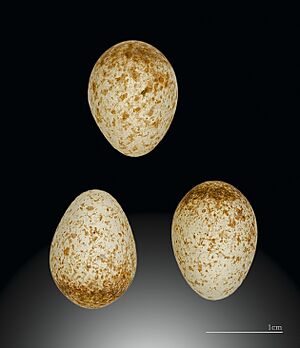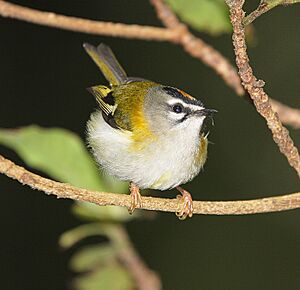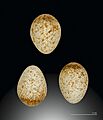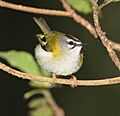Madeira firecrest facts for kids
Quick facts for kids Madeira firecrest |
|
|---|---|
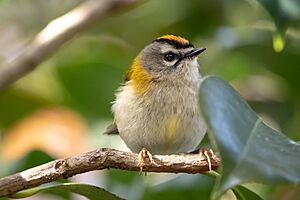 |
|
| Male | |
| Conservation status | |
| Scientific classification | |
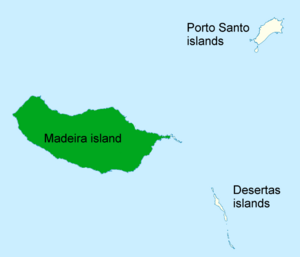 |
|
| The Madeira firecrest is an endemic resident of the main island of the Madeira archipelago | |
| Synonyms | |
|
Regulus ignicapilla madeirensis |
The Madeira firecrest, also known as the Madeira kinglet or Madeiracrest (Regulus madeirensis), is a tiny passerine bird. It lives only on the island of Madeira, which means it is endemic to that island. This bird is part of the kinglet family.
For a long time, people thought the Madeira firecrest was just a type of common firecrest. But in 2003, scientists realized it was its own unique species! It looks and sounds different from its relatives. Also, special tests on its genes showed it was truly a separate species. The Madeira firecrest has green feathers on its back and white feathers underneath. It has two white stripes on its wings. Its head is very special: it has a black stripe over its eye, a short white stripe above that, and a bright crest. This crest is mostly orange on males and yellow on females.
Female Madeira firecrests build round nests using cobwebs, moss, and small twigs. The mother bird sits on the eggs and takes care of the baby birds by herself at first. But both parents help feed the young birds once they hatch. These birds look for insects and other small creatures to eat. They find their food in different types of forests, especially those with tree heath and laurisilva trees. The Madeira firecrest is quite common on Madeira, so it is not considered to be in danger.
Contents
What Does the Madeira Firecrest Look Like?
The Madeira firecrest is a small, plump bird. It is about 9 to 10 centimeters (3.5 to 4 inches) long and weighs around 5 grams (0.18 ounces). Its back is a bright olive-green color, with a bronze patch on each shoulder. Its belly is whitish, with a bit of brownish-grey on its chest and sides. It has two white stripes on its wings, a tiny black beak, and brownish-black legs.
Its head has a very clear pattern. There is a black stripe across its eye and a white stripe above it. The top of its head has a crest that is yellow in females and mostly orange in males. Young birds look a bit different. Their backs are duller and greyish, and they don't have the bright crest or eye stripes. By their first winter, they look almost exactly like the adult birds. This kinglet usually hops around with its body held flat. Its flight is weak and fluttery, sometimes changing direction quickly.
How is it Different from Other Firecrests?
Compared to the common firecrest, the Madeira firecrest has a longer beak and legs. Its white stripe above the eye is shorter. It also has more black on its wings and a deeper golden-bronze patch on its shoulder. The male's crest is a duller orange. Young Madeira firecrests have plainer heads, unlike the young common firecrests, which have a dull stripe above their eyes.
What Does it Sound Like?
Both Madeira and common firecrests make high-pitched sounds. However, the Madeira firecrest's song has three clear parts. The common firecrest's song just gets faster slowly and covers a smaller range of sounds. Both species make high-pitched calls like zuu zu-zi-zi. But the Madeira firecrest also has a special shrill wheez and a whistled peep.
Where Does the Madeira Firecrest Live?
The Madeira firecrest lives only on the main island of Madeira. It mostly lives in higher areas, from about 600 to 1,550 meters (1,950 to 4,900 feet) high. You can find it in all kinds of forests and scrubland. It especially likes tree heaths. After breeding, it might move to lower areas.
Even though it loves tree heaths, it also lives in broom bushes, Vaccinium plants, old laurel forests, oak forests, and even forests of Japanese cedar trees (Cryptomeria japonica). However, you won't find it in areas with eucalyptus and acacia trees. These trees were brought to Madeira and have replaced many of the island's natural laurel forests.
Madeira Firecrest Behaviour
Reproduction and Life Cycle
During the breeding season, the male Madeira firecrest sings, often with its crest raised. It also has a special display where it points its beak at another bird, showing off its crest and strong face pattern. This is different from the goldcrest, which bows its head to show its crest. Madeira firecrests stay with one partner for life.
Like other kinglets, their nest is shaped like a closed cup with a small entrance hole near the top. The nest has three layers. The outside layer is made of moss, small twigs, cobwebs, and lichen. The spider webs help attach the nest to thin branches. The middle layer is moss, and the inside is lined with many feathers (sometimes up to 3,000!) and hair. The female builds the nest all by herself. The male will stay with her while she builds it, which can take a few days to three weeks.
The eggs are white with some brown speckles, similar to those of a Leaf warbler. This is different from the common firecrest's eggs, which are pink with faint reddish marks. We don't know exactly how many eggs they lay, but it's thought to be fewer than the 7 to 12 eggs of the common firecrest. The female sits on the eggs for about 14.5 to 16.5 days until they hatch. She then keeps the chicks warm until they are ready to leave the nest, which happens 19 to 20 days after hatching. Both parents help feed the chicks and the young birds after they leave the nest.
What Do They Eat?
All kinglet species, including the Madeira firecrest, mostly eat insects. They hunt small arthropods with soft bodies, like springtails, aphids, and spiders. They also eat the cocoons and eggs of spiders and insects. Sometimes, they even eat pollen. The Madeira firecrest especially likes to eat larger prey, such as moths and caterpillars.
The Madeira firecrest finds its food in trees. In pine forests, it mostly searches on the top surface of branches. In forests with leafy trees, it searches on the top of leaves. This is different from the goldcrest, which often looks for food on the undersides of branches and leaves. The Madeira firecrest also looks for food in the moss and lichen that often cover the branches and trunks of laurel and oak trees.
Status of the Madeira Firecrest
The Madeira firecrest lives on only one island, but it is quite common there. Scientists estimate that there are between 100,000 and 200,000 of these birds, and their numbers are growing. Because of this, the bird is listed as "least concern" on the IUCN Red List. This means it is not currently in danger of disappearing.
There are no major threats to the Madeira firecrest right now. However, there is some concern about its forest home being broken up or lost. For example, some native laurel forests have been replaced by eucalyptus plantations. But the Madeira firecrest can live in some of these new tree plantations, which helps it survive.
Images for kids




